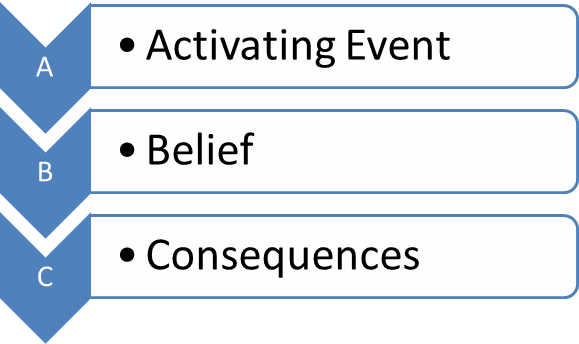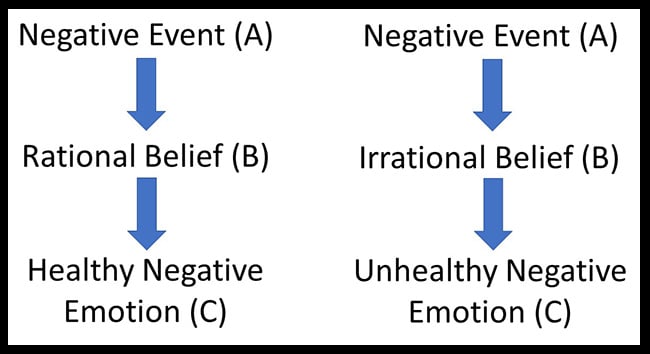On This Page:
Rational emotive behavior therapy (REBT) is a type of psychotherapy introduced by Albert Ellis in the 1950s. It is an action-oriented approach focused on helping people deal with their irrational beliefs and learning how to manage their emotions, thoughts, and behaviors in a healthier and more realistic way.
REBT focuses mostly on the present to help someone understand how their perceptions of situations can cause emotional distress, leading to unhealthy actions and behaviors that interfere with their life goals.
Once identified, understood, and adjusted to more rational thoughts, this can help people develop better relationships and approaches to situations and events.

REBT can be particularly helpful for people living with a variety of issues, but especially those experiencing the following:
- Depression
- Anxiety
- Addictive behaviors
- Phobias
- Procrastination
- Disorder eating habits
- Sleep problems
- Overwhelming feelings of anger, guilt, shame, or rage.
Background
Although REBT is considered under the umbrella of cognitive behavioral therapy (CBT), Albert Ellis was considered the pioneer of CBT, influential to Beck.
This therapy was originally called rational therapy until it went on to include emotion and behavior, taking into account these other fundamental components of the therapy.
REBT was developed as a departure from psychoanalysis, probably the most popular therapy at the time. Psychoanalysis was thought to be useful for making people feel better after getting everything off their chests.
However, Ellis questioned whether psychoanalysis helped people deal with the root cause of their problems or helped them feel better at all in the long term.
Ellis believed that humans are naturally goal-directed, but they are also self-defeating and irrational. He believed that most people are unaware that many of their thoughts about themselves are irrational and negatively affect how they behave in relationships and situations.
According to Ellis, these thoughts can result in people suffering negative emotions and engaging in self-destructive behaviors.
Ultimately, REBT recognizes that our cognition, emotions, and behavior are all connected, interacting and influencing each other.
Core principles of REBT
A core concept of REBT is the ABC model. This model explains how, while we may blame external events for our unhappiness, our perception of these events lies at the heart of psychological distress.
REBT is grounded in the idea that people generally want to do well and reach their goals.
However, sometimes, irrational thoughts and feelings get in the way of these goals. These beliefs are thought to influence how an individual perceives circumstances and events.
The ABC model is as follows:

- A – Activating – the activating event is when something happens in the environment that triggers a negative reaction or response.
- B – Belief – this describes the thoughts about the triggering event or situation, usually irrational thoughts about the activating event.
- C – Consequence – this is the emotional response to the belief, usually distressing emotions resulting from irrational thoughts or beliefs.
An example to illustrate this is to imagine a student who believes they must be perfect in everything they do. The activating event could be that they fail to get the top grade in an exam at school. The triggered beliefs about this activating event could result in irrational thoughts such as ‘I am a failure,’ ‘I should feel ashamed,’ or ‘I must do better.’ The consequences of these thoughts are that the student feels shame and guilt for not being perfectly competent in what they do, they may get upset and cry, or put unnecessary stress on themselves to work even harder next time to avoid feeling this way again.
Irrational Beliefs Addressed By REBT
Below are some examples of irrational beliefs that may be addressed in REBT:
- “If I fail this exam, my life is ruined.”
- “If I don’t excel in every area of my life, I’m a complete failure.”
- “I must always be on top of everything; any slip-up is unacceptable.”
- “My partner didn’t respond to my text, so they must be mad at me.”
- “I messed up that presentation, just like I always do.”
- “My friend is in a bad mood, and I know it’s because of me.”
Holding irrational beliefs can make it almost impossible to respond to activating situations in a healthy way.
Unhealthy feelings of anxiety are often driven by rigid and extreme attitudes, characterized by phrases like “must,” “should,” “have to,” and “need to.” These attitudes can lead to intense negative emotions.
Goals Of REBT
In REBT, individuals learn to differentiate between healthy negative feelings, which can be constructive during challenging situations, and unhealthy feelings of anxiety. Healthy negative feelings can guide a person to take appropriate action or accept situations beyond their control.

REBT emphasizes personal responsibility for emotions and encourages the use of constructive language.
Going back to the aforementioned example, a student who previously felt anxious about not getting the top grade might realize they have a choice in how they feel and could say, "I made myself anxious, so I can choose not to make myself anxious."
REBT helps individuals shift from blaming external circumstances for their distressing emotions to recognizing that their thoughts and beliefs are the primary drivers of those emotions.
Techniques
During REBT, the therapist will help the client learn how to apply the ABC model to their daily lives. They work with the individual to change those beliefs and their emotional response to situations.
An important step in this process is recognizing the underlying beliefs that lead to psychological distress. In many cases, these come as absolutes such as ‘I must,’ ‘I should,’ and ‘I can’t’ statements.
The therapist will usually discourage people from using these statements as they are unhelpful and irrational.
Below are some of the techniques of REBT:
Problem-solving
Problem-solving is intended to help the person address the A in the ABC model.
This involves addressing the activating event or adversity head-on. Some common problem-solving methods include:
- Teaching assertiveness
- Learning social skills
- Learning decision-making skills
- Learning conflict resolution skills
Cognitive restructuring
Cognitive restructuring focuses on helping the person to change their irrational beliefs with techniques such as:
- Reframing
- Rationalizing techniques
- Guided imagery and visualization
- Using humor
- Exposing yourself to the fear
The REBT therapist may also use disputation to challenge a client’s irrational beliefs.
This involves questioning the validity of these beliefs, asking for evidence, and exploring alternative, more rational perspectives.
The therapist helps the client see that their irrational beliefs are not based on facts and encourages them to adopt more rational, evidence-based thinking, which can lead to healthier emotional responses and behaviors.
Coping techniques
Coping techniques are taught to be learned in situations where the person cannot change the event or is struggling even though they are using rational thinking. Some coping techniques include:
- Relaxation
- Hypnosis
- Meditation
- Mindfulness
- Breathing exercises
Acceptance
The therapist will usually teach their clients three forms of acceptance:
- Unconditional self-acceptance – this is where the person recognizes that they have good and bad points – they are flawed, but this doesn’t make them any less worthy than another person.
- Unconditional other-acceptance – this is where the person recognizes that some people won’t treat them fairly, and there is no reason why everyone should treat them fairly. Although others will not treat them fairly, these people are no less worthy than any other person.
- Unconditional life-acceptance – this is where the person recognizes that life is not always going to go the way they want, and there is no reason why it must go the way they want. They learn to accept that they may experience some unpleasant things in life, but life itself is never awful and is usually always bearable.
REBT Activities
Imagining the worst
Often, people will catastrophize situations, meaning that they use worst-case thinking. Catastrophizing is a common cognitive distortion where people fear the uncertainty of potential negative events despite a lack of objective evidence to support this.
REBT therapists can encourage clients to imagine the worst-case scenario when attempting to avoid thinking about it for fear of becoming more anxious. Utilizing the worst-case scenario can help the client realize the following:
- The worst-case scenario is unrealistic and, therefore, unlikely to happen.
- Even if it did occur, the worst-case will probably still be tolerable.
- If the worst does happen, they would still be able to manage the outcomes and prevent them from becoming catastrophic.
Blown out of all proportion
This activity involves the use of imagery and humor to tackle irrational thoughts. The therapist will ask the client to imagine the thing they fear the most actually happening.
However, instead of encouraging them to visualize this realistically, the therapist will ask them to visualize it to an extreme level.
When their worst fears become exaggerated, they can become humorous. The idea is that laughing at blown-up fears will help the client get more control over them.
Disputing irrational beliefs (DIBS)
DIBS is one of the most popular cognitive restructuring techniques in which the therapist questions the client’s beliefs head-on, causing them to rethink them, or they could ask the client to imagine another point of view that they may not have considered before.
Rather than the therapist being warm and supportive all the time, Ellis suggests that therapists should sometimes be blunt and honest to push people toward challenging their thoughts.
Disputing is a skill that can be learned in the long term to help people manage their emotional responses and limit some of their harmful beliefs.
A DIBS activity may include writing down a core belief someone holds and then considering the following:
- Are there any objective facts to support this belief?
- What proof is there that this belief is true/false?
- What is the worst outcome that could occur?
Ellis recommended recording the irrational belief and then writing several statements to dispute this so the person can see more evidence suggesting their belief is false rather than true.
How Effective is REBT?
REBT has shown to be effective in addressing a variety of mental health conditions and situations as outlined below:
- REBT is effective in reducing attachment anxiety, psychological inflexibility, obsessive-compulsive disorder symptoms, and emotional dysregulation (Hoseini et al., 2013).
- REBT has lasting positive effects even after therapy has ended and is as effective as cognitive therapy and medication for treating depression (David et al., 2008).
- In an educational context, REBT group counseling has been found to reduce anxiety in school students compared to regular group counseling (Misdeni et al., 2019).
- REBT is effective in reducing academic stress for students, and its benefits persist for months after therapy concludes (Priya & Padmavathi, 2021).
- In the workplace, group REBT can reduce job-related stress and burnout while increasing job satisfaction and commitment (Kim & Yoon, 2018).
- In the realm of sports psychology, REBT is an effective treatment option for athletes experiencing mental health issues, helping them manage unhelpful beliefs, emotions, and anxiety (Turner, 2016).
Limitations of REBT
While REBT has evidence to support its efficacy, some limitations and critiques have been noted.
The confrontational style of disputing irrational beliefs directly is a major area of controversy. This approach could potentially re-traumatize clients who have experienced abuse or invalidation in the past.
The confrontational style may also not suit clients from certain cultural backgrounds who value indirect communication and humility.
Additionally, REBT could arguably simplify psychological distress too much by focusing only on irrational beliefs. Factors such as childhood experiences and trauma play an important role as well.
From a neuroscience perspective, it can be questioned whether REBT sufficiently addresses emotional processing in the limbic system of the brain. While REBT aims to change thoughts and behaviors, emotions may not change as easily. More research is still needed into the neurobiology of REBT.
Finally, REBT may feel less personalized than other therapies and provides manualized rather than individualized treatment.
Personal Experiences of REBT
Below are accounts of individuals’ experiences of REBT sessions:
“by using someone as a sounding board [...] Well you almost hear yourself speaking and saying ‘that’s ridiculous’ or something.”. “that's the difference, that, you know, I will go out and do things, you know, no matter how hard I think it might be, [...] I'll meet that challenge. [...] and I'd allow myself to be nervous. [...] Yeah. Whereas before, you know, I shouldn't be nervous. I shouldn't be this, shouldn’t be that. Shoulds”. “But I realised, over time, that there really was a conscious thought there, you know. There's an underlying belief in there somewhere, [...] that's causing me to feel this way, [...] And that, [...] that's the event, that's the belief and the consequence is my feeling this way. “I wouldn't have thought it was at all possible, but the work that I've done, you know, in digging out what the underlying thoughts are, you know, of making the unconscious conscious [...] and knowing that, that you can, with a lot of practice in my, [...] particular instance, erm knowing that you can has made a hell of a difference.” (From Meadon, 2010).
REBT vs. CBT
Below are some of the main differences between REBT and CBT:
| Aspect | REBT | CBT |
|---|---|---|
| Origins | Considered an original form of CBT | Developed separately by Aaron Beck |
| Core Principle | Emphasizes self-constructed thinking as the basis for emotional disturbance | Focuses on undoing dysfunctional automatic thoughts learned since childhood |
| Self-Esteem Approach | Teaches unconditional self-acceptance | Focuses on others’ acceptance and reinforces positive qualities |
| View on Anger | Views all anger as having a condemning core | Recognizes some healthy and appropriate anger |
| Therapeutic Style | May use humor and be confrontational | Generally more polite and less confrontational |
| Popularity & Research | Effective but less popular with less research support | Widely popular with extensive research backing |
The choice between REBT and CBT depends on individual preferences, specific issues, and therapy goals. Both approaches share common principles but have distinct philosophical and practical differences.
The Therapeutic Relationship in REBT
A strong therapeutic relationship is important for the success of REBT. Because this approach can involve blunt, confrontational disputing of your irrational beliefs, having a solid bond and trust between you and the therapist is crucial.
The therapist must establish rapport and be sensitive in challenging you. The confrontational style is not intended to attack you but to question your harmful thought patterns. Still, this approach can feel aggressive if proper trust is not built between you and the therapist.
You must feel safe being vulnerable and opening up to the therapist. The therapist also needs to demonstrate competence, care, and integrity for you to feel respected and understood. When you feel this trust with the therapist, you will be more receptive to the direct disputation techniques.
A safe therapeutic alliance gives you the confidence to take risks in changing your beliefs and behaviors. The therapist also provides encouragement through this challenging REBT process. With a good relationship as a foundation, the confrontational approach can be an effective catalyst for change.
Getting the Most out of REBT
To optimize outcomes from REBT, your active engagement is vital. Being more open to change and willing to challenge your thoughts/behaviors means you’re likely to benefit more.
Completing homework assignments between sessions gives you the opportunity to apply REBT techniques to your daily life. This helps cement new thinking patterns. Attending all therapy sessions is also important so you can get the full scope of REBT – missed appointments disrupt the process.
You should be prepared to feel some discomfort – it’s never easy to acknowledge and let go of irrational beliefs that may have developed over a lifetime. But leaning into the confrontation and fully committing to the REBT process is key. Change is difficult, but very worthwhile when you and the therapist work together actively.
Do you need mental health support?
USA
If you or a loved one are struggling with symptoms of an anxiety disorder, contact the Substance Abuse and Mental Health Services Administration (SAMHSA) National Helpline for information on support and treatment facilities in your area.
1-800-662-4357
UK
Contact the Samaritans for support and assistance from a trained counselor: https://www.samaritans.org/; email jo@samaritans.org .
Available 24 hours a day, 365 days a year (this number is FREE to call):
116-123
Rethink Mental Illness: rethink.org
0300 5000 927
References
David, D., Szentagotai, A., Lupu, V., & Cosman, D. (2008). Rational emotive behavior therapy, cognitive therapy, and medication in the treatment of major depressive disorder: a randomized clinical trial, posttreatment outcomes, and six‐month follow‐up. Journal of clinical psychology, 64(6), 728-746.
Hoseini, T. H. M., Vaziri, S., & Kashani, F. L. (2013). The Effect of REBT on Reducing Somatization Syndrome, Obsessive-Compulsive Disorder, and Interpersonal Sensitivity of Women living in Qom.
Kim, H. L., & Yoon, S. H. (2018). Effects of group rational emotive behavior therapy on the nurses’ job stress, burnout, job satisfaction, organizational commitment and turnover intention. Journal of Korean Academy of Nursing, 48(4), 432-442.
Marsinun, R. (2016). The effectiveness of Rational Emotive Behavior (REB) counseling to reduce anxiety in facing student exams at SMPN 150 Jakarta. In Proceedings of the National Seminar Series (pp. 306-327).
Meaden, A. (2010). The experience of rational emotive behaviour therapy.
Misdeni, M., Syahniar, S., & Marjohan, M. (2019). The effectiveness of rational emotive behavior therapy approach using a group setting to overcome anxiety of students facing examinations. International Journal of Research in Counseling and Education, 3(2), 82-88.
Priya, S. S., & Padmavathi, P. (2021). Assess the effectiveness of rebt on academic stress Among Adolescent Girls. TNNMC Journal of Obstetrics and Gynaecological Nursing, 9(2), 36-41.
Turner, M. J. (2016). Rational emotive behavior therapy (REBT), irrational and rational beliefs, and the mental health of athletes. Frontiers in psychology, 7, 1423.

